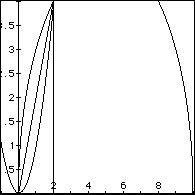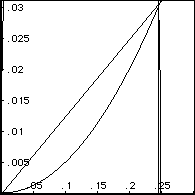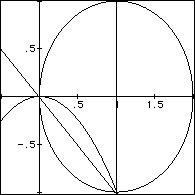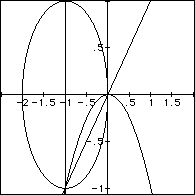
A Q C
and a
Geometric Solution of the Cubic
by
June Jones
About 900 years ago, Omar Khayyam, the Persian poet and mathematician, found a geometric solution of a cubic. He solved a cubic in the form x3 +a2x = b by using a pair of intersecting conic sections.
The figures in this essay were created on Algebra Xpresser but the TI-81 or 82 would be appropriate also. With one of these or the grapher or software of choice, the reader may recreate this ancient procedure. As you perform the following steps, vary the values of a and b.
1.) Construct a parabola of the form x2 = ay.
2.) Draw a semicircle with diameter AC = b/a2 on the x-axis. Let P be the point of intersection with the parabola.
3.) Drop a perpendicular from P to the x-axis to produce a point Q.
Your basic figure should look like the one pictured below. It has been labeled so that an example can be looked at before we tackle the general case. It is set up with a = 1 and b = 2. Thus AQ = 1, AC = 2, and QP = 1. Our cubic for this example becomes x3 + x = 2.

A Q C
We already know that the real number solution to x3 + x = 2 is 1. On the figure we see two places that this value occurs. Let's try another example and see if one of these locations might be the solution we are seeking. The reader can tentatively verify the values by using the software tracer.
Let a = 1 and b = 10. Now x3 + x = 10 and x = 2. The equations necessary for construction are x2 = y and y = (10x - x2)1/2.

A Q C
The above shows: AQ = 2, AC = 10, and QP = 4.
This time let b = 1 and a = 2. Thus we have the parabola x2 = 2y and the semicircle y = (x/4 - x2)1/2.

A Q is approximately .2465
The cubic in question here is x3 + 4x = 1. This should be enough to convince the reader that the length of AQ is the positive real root that we seek of the given cubic. That is, the x coordinate of P is the root.
The formal proof is as follows:
AQ2 = a(PQ)
AQP ~ PQC thus (AQ)/(PQ) = (PQ)/(QC)
PQ2 = (AQ)(QC)
= AQ(b/a2 - AQ)
= b(AQ)/a2 - AQ2
= a2(PQ)2 = b(AQ) - a2(AQ)2
AQ3 + a2(AQ) = b
Thus x3 + a2x = b.
This ancient procedure limits the solution to Quadrant I. Consider the same form x3 + a2x = b, but this time impose the condition AC = the absolute value of the ratio b/a2.
If a = -1 and b = 2, we get x3 + x = 2. We must use the semicircle in Quadrant IV, which puts P in Quad IV, but the x- coordinate of P is still 1.

P
Now consider a = 1 and b = -2. This produces the equations y = x2 and y = (2x - x2)1/2, but the cubic is x3 + x = -2. The question now becomes: Can we amend Khayyam's graphic solution to include the negative real root?
We defined AC as the diameter with ratio b/a2. Since the diameter can't be negative, we need to specify that if b is negative, the semicircle shifts to the left of the vertical axis. And in the case when a is negative, instead of using a semicircle, it is now convenient to use the entire circle.
Try this out on the following for x3 + a2x = b: let a = -1 and
b = -2. Thus x3 + x = -2.
1.) Construct a parabola of the form x2 = ay. Here x2 = -y.
2.) Draw a circle with diameter AC = the absolute value of b/a2 on the x-axis. Here AC = 2 and since b is negative, the circle is in Quadrant II and III, and is tangent to the vertical axis from the left. Here (x + 1)2 +y2 = 1. Let P be the point of intersection with the parabola.
3.) The x coordinate of P is the root. Here x = -1.

P
Thus, we have a method that can find the negative real root as well as the positive real root for a cubic of the form x3 + a2x = b.